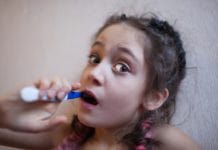The immune system is essential as it is a complex network of cells and proteins that defend the body against infections. Other parts of this system are made up of white blood cells, antibodies, lymph nodes, and organs, and the system’s primary purpose is to kill the pathogen without harming the host.
The dental field is considered a high-risk job because we are encountering pathogens and viruses daily. Keeping our personal immune system at its peak helps us, our co-workers, and our patients.
Immunity is the ability to use the body’s defenses to ward off damage or disease. The immune system also produces immunology memory. When bacteria, viruses, or toxins invade the body again, the body will recognize it and treat it as an unwelcome guest and attack it successfully to prevent it from doing damage.1
A strong, healthy immune system fights off pathogens easily, quickly, and efficiently. A way to tell the immune system is working is when the body has a reaction to a pathogen, such as inflammation, fever, vomiting, headache, runny nose, sneezing, and sore throat. A strong immune system provides quick recoveries, less severe and infrequent infections, and more energy to the body.
Signs of a Compromised Immune System
A poor, weak, or compromised immune system is more prone to infections. When this happens, the body must play catch up and come from behind to fight any bodily invasion. The body is compromised and more prone to consistent infections from viruses and bacteria, placing the body into a constant fighting stage. This makes illnesses more severe or harder to treat. A weakened immune system is regularly dealing with infections that a robust immune system would not welcomingly receive.2
High-stress levels lower the immune system’s response and decrease lymphocytes, which increases the risk of viruses and colds.3
It takes longer to recover from a cold with a compromised immune system, while infections happen more frequently. A weakened immune system will develop constant colds throughout the year with a longer recovery. In contrast, a healthy immune system may develop about two to three colds a year with a normal recovery time of seven to 10 days. It takes three to four days to develop antibodies and fight off pathogens with a healthy immune system.3
Frequent infections such as ear, pneumonia, chronic sinusitis, or receiving multiple bouts of antibiotics a year is a sign of a weakened immune system.3 Constant fatigue with consistent sluggishness and exhaustion is forcing the body to conserve energy to fuel the immune system to fight off pathogens.3
Stomach issues, including frequent diarrhea, gas, or constipation, could be a sign of low amounts of healthy gut bacteria that may increase the risk of viruses or chronic inflammation. The beneficial bacteria and microorganisms that live in the gut defend it from infection and support the immune system.3
Wounds that are slow to heal may be a sign of a weakened system. After a skin injury, the body naturally protects the wound by sending nutrient-rich blood to the injury site to help regenerate new skin. The healing process depends on healthy immune cells. In contrast, if the immune system is sluggish, the skin won’t quickly regenerate, taking a longer time to heal.3
Immune System Types
The two types of immunity are innate and adaptive. They both fight off microbes but at different levels of the body. A microbe is considered a bacterial virus, fungi, parasite, or any organism that could cause pathogenic harm to the body if it were to gain access.4
Innate − Innate immunity, also called resistance or nonspecific immunity, includes the first and second line of defenses. It’s the nonspecific defenses inherent at birth and is always present and available for rapid protection. This is nonspecific, meaning it wards off all invaders and has the most rapid response. Innate immunity includes surface barriers and internal defenses.
The skin is one of the first-line defenses and is considered a surface barrier. It provides a formidable barrier to the entry of microbes into the body. Organisms are rarely able to penetrate a healthy skin surface. The skin produces sebum that has antimicrobial properties. The pH is acidic to inhibit bacterial growth, and the skin is constantly shedding to remove microbes from the skin.5
The mucous membrane, the other first-line defense, is considered an internal defense, providing moistening and lubrication to surfaces. Its viscosity acts as a trap for microbes trying to gain access inside the body. Mucous membranes are located where the body’s cavities open to the outside.
The second line of defense is when the first line of the skin and mucous membranes are breached.This defense system includes four antimicrobial substances. Interferons interfere with virus replication in unaffected cells. The complement system is a set of various proteins and enhances the attraction of immune cells to the site of injury or creates holes in the plasma membrane. Iron-binding proteins inhibit the growth of microbes. The last one is antimicrobial proteins that directly kill the microbes and attract other immune response cells.
Phagocytes are the neutrophils and macrophages and provide constant detection and immediate response to a microbial invasion.
Natural killer cells (NK cells) specifically target virus-infected and tumor cells. They do exactly what the name suggests and destroy compromised host cells by releasing toxic proteins that disintegrate the targets cells membrane.
Inflammation is a nonspecific defense response to either internal or external tissue damage. The act of inflammation destructs microbes, toxins, or foreign matters and prevents them from spreading to other tissues while preparing the site for repair and healing.
Fever is when the body temperature elevates, thus intensifying interferons, inhibits the growth and replication of microbes, and directly kills microbes to speed up the healing process.5
Adaptive − Adaptive immunity, also called acquired or specific immunity, is considered the third-line defense, which involves recognizing a specific microbe or substance due to memory or previous exposure. The highly specialized system identifies a particular microbe or antigen (a substance recognized as foreign) once the innate defenses have been breached.
Although the initial response time is slower than innate defenses, adaptive immunity effects last a lifetime because of its memory function. Once the body is exposed to a microbe, there is quick recognition on any subsequent visit.
Adaptive immunity is housed mainly in the lymphatic system while it uses the blood as a highway to transport specialized cells. This defense is where the B and T cells arrive to the game from the lymphoid stem cells. Cell-mediated immunity happens inside the cells, while antibody-mediated happens outside of the cells. They could work independently or concurrent with each other depending on the antigen type or location.
The B cells mature in the bone marrow and are considered antibody or humoral mediated immunity. They transform into plasma cells and synthesize and secrete antibodies that bind to inactive specific antigens. Each individual cell produces thousands of antibodies over its lifetime, depending on the exposure to antigens.5
The T cells mature in the thymus and develop into helper T cells and cytotoxic T cells and are considered cell-mediated immunity. Helper T cells aid both cell and antibody-mediated pathways, while cytotoxic T cells directly attack invading antigens.
Initial Exposure
Upon initial exposure to an antigen, the body lacks specific antigen receptors for a response. This protection of immunity needs to be created for each and every novel antigen encountered throughout life.
With each new encounter with an antigen, symptoms occur such as flu or cold-like symptoms with coughing, sneezing, fever, runny nose, sore throat, achiness, tiredness, headaches, and vomiting. This is what helps generate immunity to the antigen. This happens because the body hasn’t yet generated immunity to that specific antigen yet.
Within hours or days after exposure, T and B cells undergo clonal selection. Lymphocytes divide and specialize into dedicated cells with unique receptors for a particular antigen in the membrane. After clonal selection effector and memory cells are made, effector cells (active helper T cells, active cytotoxic T cells, and plasma cells) are responsible for the antigen’s destruction or inactivation.
Memory cells (memory helper T cells, memory cytotoxic T cells, and memory B cells) do not initially participate in the immune response. Still, they remain in the system to quickly respond if an antigen returns in the future. Usually, the second response of the same antigen doesn’t have to go through the cloning process again, making the response so vigorous that the antigen is destroyed before any symptoms arise.5
There are simple ways to help prevent or lower the risks of a cold or flu. Eating healthy foods, vitamins, supplements, and exercising are proven and encouraged to maintain a healthy immune system and lower the impact of contracting an annual virus.
Healthy Eating
Nutrition plays a huge role in a healthy immune function. Vegetables provide good sources of vitamins, minerals, and antioxidant polyphenols. Maintaining protein adequacy improves the immune system since immune cells and antibodies are made from proteins. Avoid refined foods since they are nutrient deficient and add to the inflammatory role.
To decrease immunity, refined sugar and fried foods are the biggest unfavorable factors in the diet aspect.
Refined sugar has a suppressive effect on the immune system. Glucose competes with vitamin C for entrance into the cell. When insulin levels increase from glucose, a growth hormone is released and depresses the immune system. A diet high in fried foods depresses the immune system, increases inflammation, and risk for autoimmunity.
Vitamin C − Vitamin C contributes to the immune defense by supporting the innate and adaptive immune system’s cellular functions. Vitamin C accumulates in phagocytic cells and enhances microbial killing. When in lymphocytes, it enhances the division and growth of B and T cells. It supports the barrier function of the skin and prevents and treats respiratory and systemic infections. Vitamin C deficiency results in impaired immunity, higher susceptibility to infections, and enhanced inflammation. Vitamin C can be attained through supplements and citrus foods.6
Vitamin D − Vitamin D plays several beneficial roles in the body, including the immune system. It plays a huge role in the innate antimicrobial response, helping to disrupt bacterial cell membranes, and has potent antibacterial activity. B and T cells reduce inflammation, increase anti-inflammatory activity, and reduce infection risks such as colds and flu. Lower levels of vitamin D are associated with increased infections, including the upper respiratory tract. Vitamin D comes from the sun, foods, and supplements.7
Elderberry − Elderberry has properties to help fight viruses and boost the immune system through the many antioxidants and vitamins. Its polyphenols support the immune system by increasing the number of white blood cells. It decreases inflammation, reduces the severity and length of the flu. Elderberry is found in supplements, lozenges, gummies, capsules, and liquid form.
Licorice − Licorice is a common herb in traditional Chinese medicine and has shown to be useful as an antiviral, antimicrobial, antitumor, and anti-inflammatory substance. The licorice root has the ingredients glycyrrhizin, liquiritigenin, and glabridin, which give it antiviral properties. Studies show this may be effective towards SARS-CoV (severe acute respiratory syndrome-related coronavirus).9,10
Glycyrrhizin inhibits the virus replication, absorption, and penetration in the early steps of the replicative cycle.11 It boosts interferon levels to attack viruses, reduce inflammation, and maintains healthy lung tissue. The flavonoids in licorice root suppressed pulmonary inflammation by inhibiting neutrophils. Licorice is found in food, tea, and supplements.
Zinc − Zinc is very advantageous since it increases white blood cells’ production to fight infection and helps T cells, B cells, natural killer cells, macrophages, and neutrophils fight more aggressively. It helps with antioxidant and anti-inflammatory activity. It also reduces the number of infections and the duration of a cold or flu when taken within the first 24 hours of symptoms. A zinc deficiency adversely affects the growth and function of T and B cells. Zinc is found in cold medicine products, supplements, and food.12
Exercise
Exercise provides a positive boost to both the innate and acquired immune systems. After an exercise session, instant mobilization of immune cells starts to circulate in the blood. Depending on the exercise, immune cells, macrophages, and neutrophils, circulate at an increase of 50% to 400%. Although this is beneficial to the immune system, these cells’ circulation returns back to baseline three hours after exercising.
Regular exercise reduces inflammation allowing the immune system to perform better. Acute inflammation is the immune system working, while chronic inflammation can slow down the immune system. Increasing blood flow helps clear bacteria from the airways, causing a brief increase in body temperature to strengthen and protect antibodies. More active people tend to acquire fewer upper respiratory tract infections.13
From an individual level, why not have the best immune system the body can offer, having an advantageous start over any foreign object that accesses the body? Our careers will last longer with a healthy immune system.
Before you leave, check out the Today’s RDH self-study CE courses. All courses are peer-reviewed and non-sponsored to focus solely on high-quality education. Click here now.
Listen to the Today’s RDH Dental Hygiene Podcast Below:
References
- Immune System Explained. (2017, December). Better Health. Retrieved from https://www.betterhealth.vic.gov.au/health/conditionsandtreatments/immune-system
- Fletcher, J. (2020, June 03). How to Stay Healthy with a Weak Immune System. Medical News Today. Retrieved from https://www.medicalnewstoday.com/articles/324930#tips-to-stay-healthy\
- Hasan, N. (2020, March 23). 6 Signs You Have a Weakened Immune System. Penn Medicine. Retrieved from https://www.pennmedicine.org/
- How Does the Immune System Work? (2020, April 23). Informed Health. Cologne, Germany: Institute for Quality and Efficiency in Health Care (IQWiG). Retrieved from https://www.ncbi.nlm.nih.gov/books/NBK279364/
- Immunological Memory. (2008) Clinical Immunology. Third Edition. Retrieved from https://www.sciencedirect.com/topics/medicine-and-dentistry/immunological-memory
- Carr, A.C., Maggini, S. Vitamin C and Immune Function. 2017; 9(11): 1211. doi:10.3390/nu9111211.
- Aranow, C. Vitamin D and the Immune System. Journal of Investigative Medicine: The Official Publication of the American Federation for Clinical Research. 2011; 59(6): 881-6. doi:10.2310/JIM.0b013e31821b8755.
- Mandl, E. (2018, March 8). Elderberry: Benefits and Dangers. Retrieved from https://www.healthline.com/nutrition/elderberry#bottom-line
- Wang, L., Yang, R., Liu, C. The Antiviral and Antimicrobial Activities of Licorice, a Widely-used Chinese Herb. Acta pharmaceutica Sinica B. 2015; 5(4): 310-5. doi: 10.1016/j.apsb.2015.05.005. Retrieved from https://www.ncbi.nlm.nih.gov/pmc/articles/PMC4629407/
- Tyler, S. (2019, November 25). Licorice Root: Potent Antiviral, Antimicrobial and Antifungal Botanical Medicine. Retrieved from https://www.botanicalmedicine.org/licorice-root-antiviral-antimicrobial-antifungal/
- Cinatl, J. et al. Glycyrrhizin, an Active Component of Licorice Roots, and Replication of SARS-associated Coronavirus. Lancet (London, England). 2003; 361(9374): 2045-6. doi:10.1016/s0140-6736(03)13615-x. Retrieved from https://www.thelancet.com/journals/lancet/article/PIIS0140-6736(03)13615-X/fulltext
- Prasad, A.S. Zinc in Human Health: Effect of Zinc on Immune Cells. Molecular Medicine (Cambridge, Mass.).2008; 14(5-6): 353-7. doi: 10.2119/2008-00033.Prasad. Retrieved from https://www.ncbi.nlm.nih.gov/pmc/articles/PMC2277319/
- Chen, Stephen, (2020, May 25) The Benefits of Exercise to the Immune System. BJU Today. Bob Jones University Retrieved from https://today.bju.edu/health-insights/benefits-of-exercise-to-immune-system/











